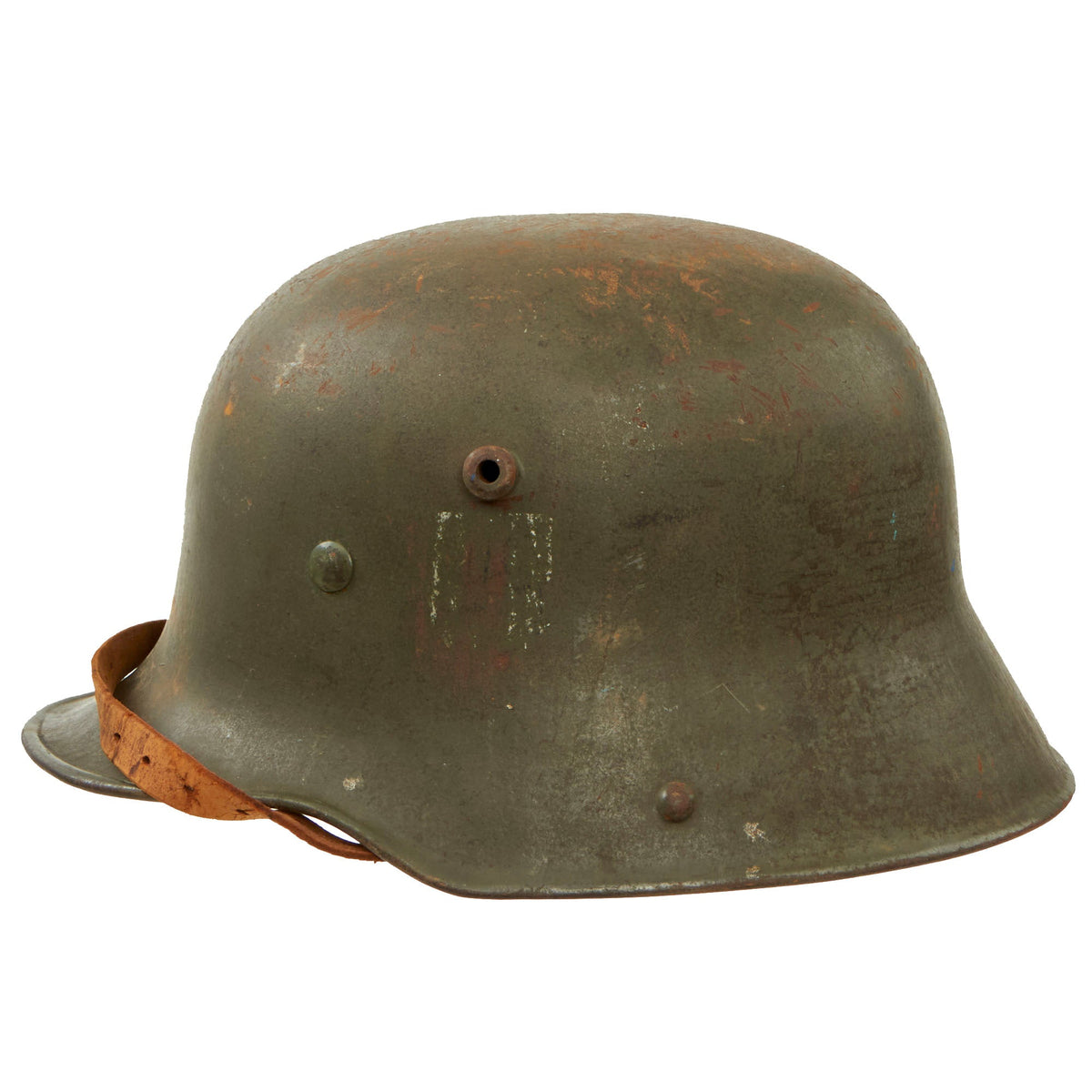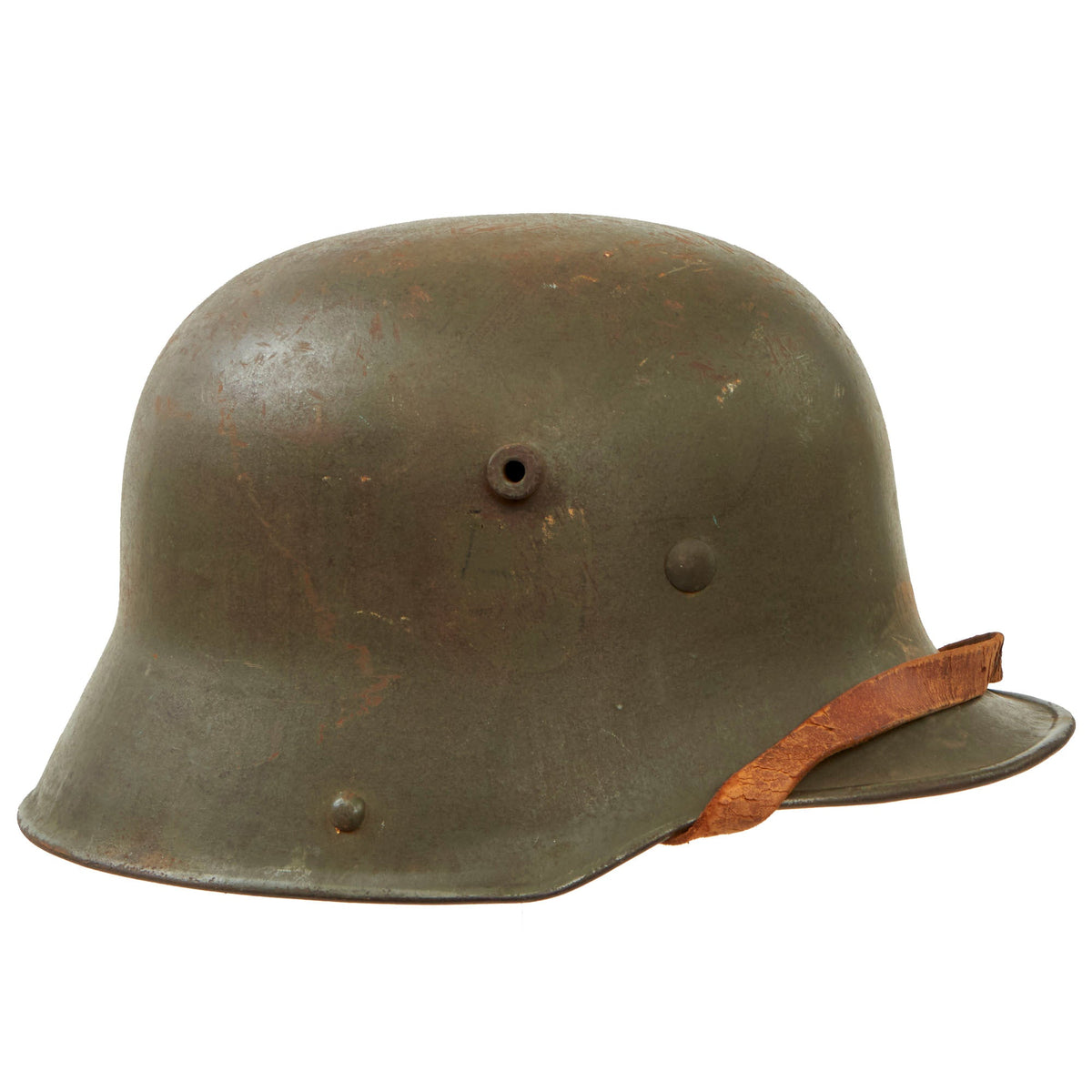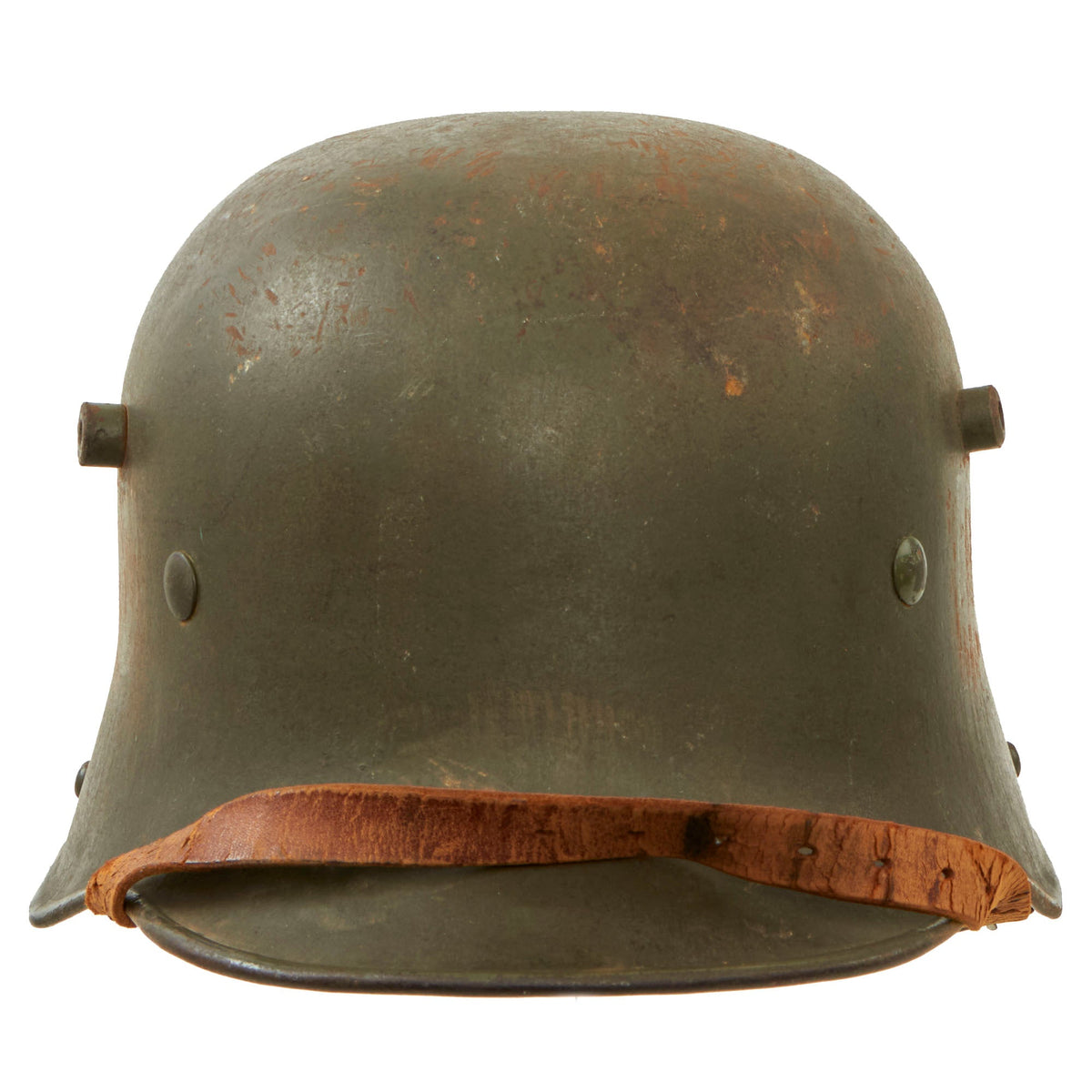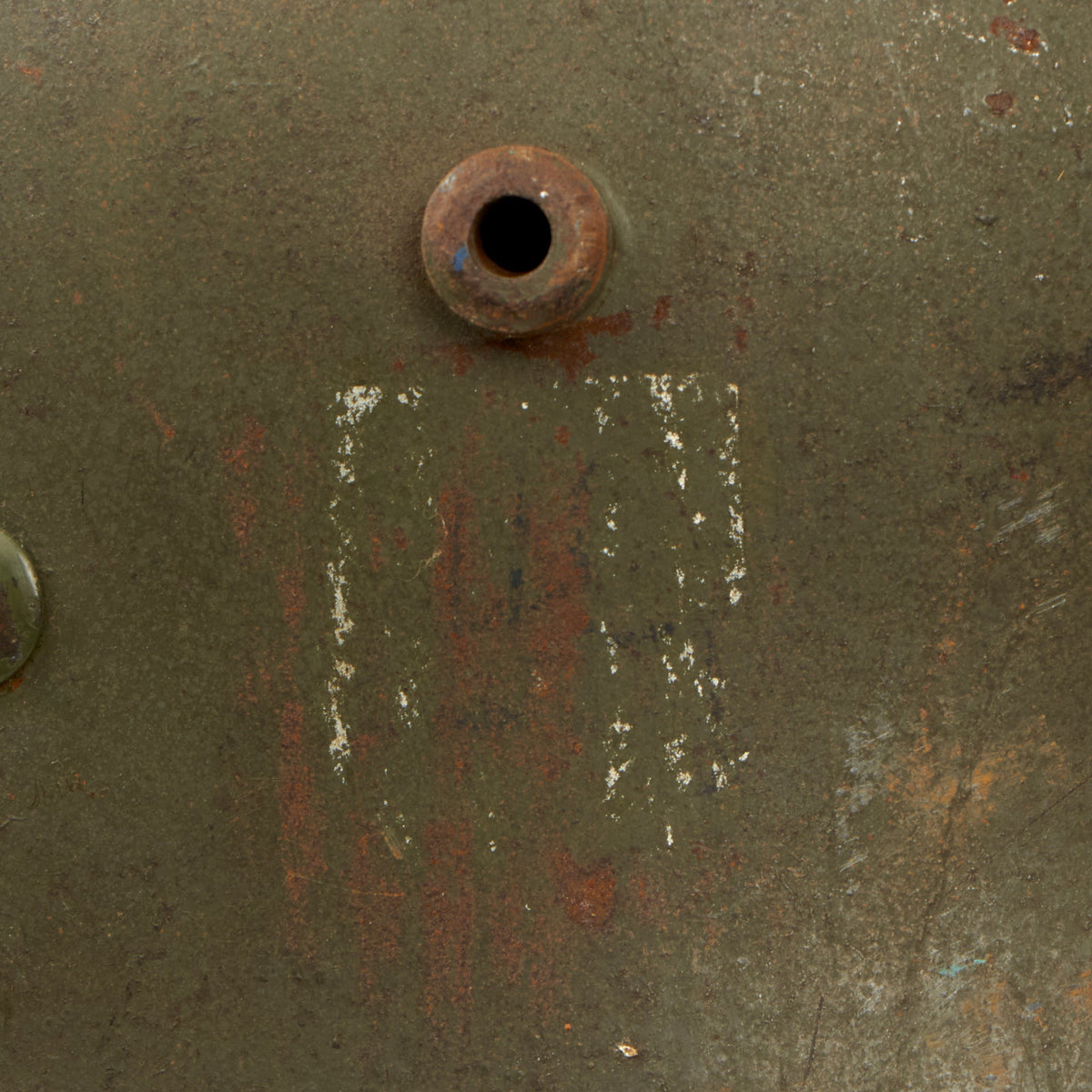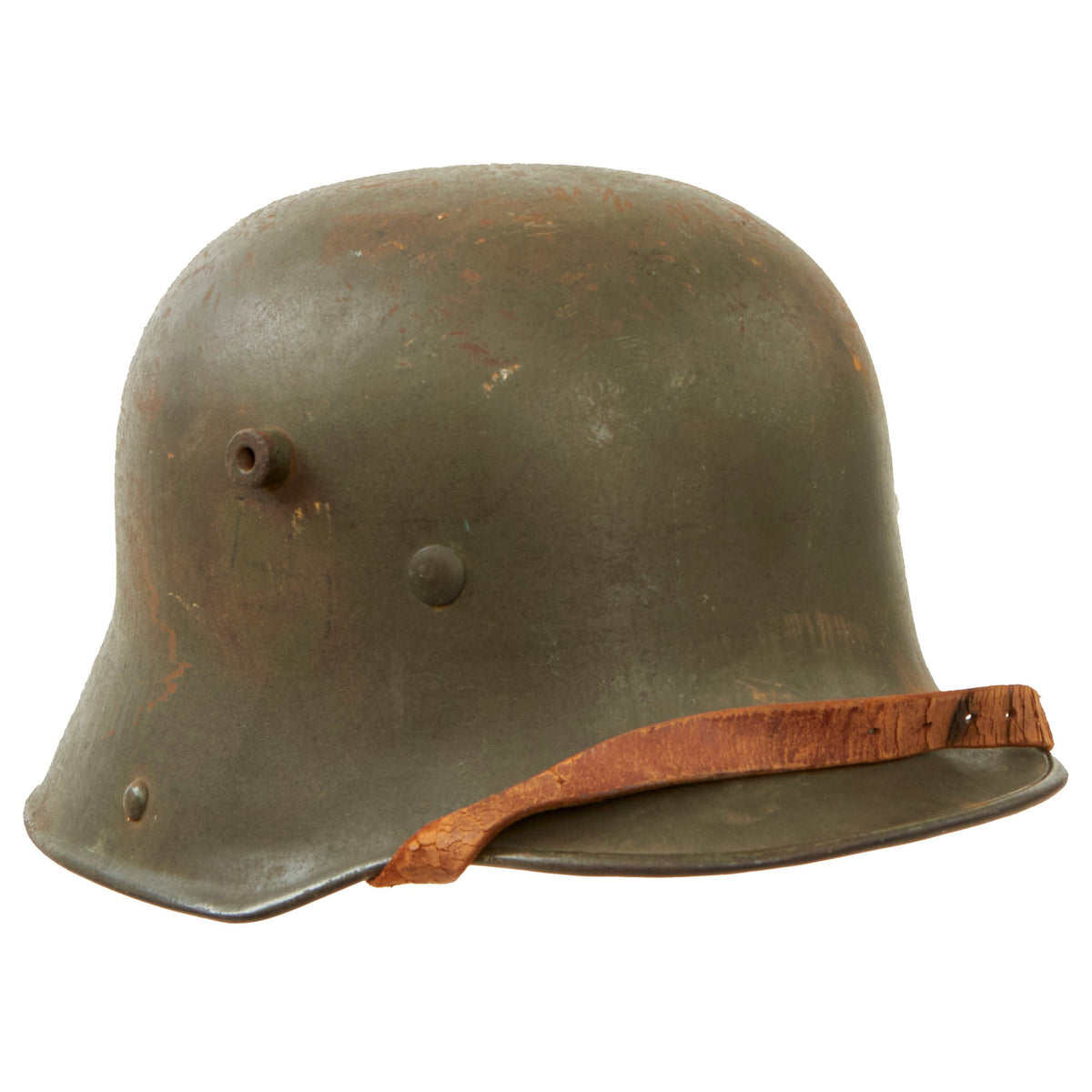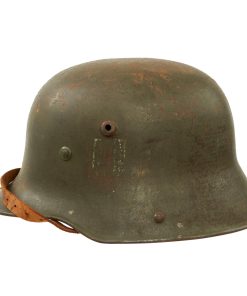Original German WWII M16 Transitional Heer Army Former Double Decal Helmet with Damaged 56cm Liner & Chinstrap – Stamped Si66 Original Items
$ 595,00 $ 178,50
Original Item: Only One Available. This is a lovely example of a WWI M16 helmet, which was converted for use by the Third Reich in the 1930s before the widespread issue of the M1935 helmet. During the process it looks like may have been repainted with Pre-War Apfel-grün (apple green), and the helmet was fitted with a pre-war M-31 Leather liner, with the correct WWII pattern split pins. It was then fitted with Heer “Double Decals”, a Heer (army) eagle over the left ear, and the German Tri-color “National Colors” decal, over the right ear.
After that, it looks to have seen long service during the war, with the paint now showing an overall oxidized patina due to wear and age. It also has both decals almost completely removed for some reason, possibly for use post war. We can still see traces of the decals, and can see that they we removed after much of the war on the helmet occurred, definitely an interesting example!
The shell is stamped on the inner left side over the ear with Si.66, indicating that Eisenhuette Silesia in Paruschowitz Oberschlesien manufactured it. This company made shells in sizes 62 and 66 for the war effort. It also has dome stamp Bi 6 0 8 on the top inside of the shell, which indicates that the steel was produced by rolling mill Bismarckhutte in Oberschlesien (Upper Silesia). Size 66 is a nice large size that can accommodate liners from 58cm to 60cm or US 7 1/4 to 7 1/2. Size 66 shells are always hard to find and are therefore more valuable to a collector.
Interestingly, on this shell the original chin strap mounting lugs were replaced with what look to be Austrian style chin strap attachment points, however they are still in the lower position they would be on an M16 helmet. This occurred before it was repainted in the 1930s, so we think it may be a Weimar period alteration. The shell also retains both of the extended ventilation side lugs, which are the correct short version without any step for the larger size 66 shell. This would ensure proper installation of a Stirnpanzer brow plate regardless of shell size.
All three original liner retaining pins are intact and have complete original paint on the ends. The interior of the helmet still has an original M31 leather liner with all eight fingers present, however the right side has what looks to be a long cut through the leather, almost removing two of the fingers. The top tie string is still present, but in this case it hardly makes a difference, as the liner is definitely not “intact”. The liner band is aluminum, with square aluminum chin strap loops attached to reinforced sides. This is the last pattern before the move to galvanized steel bands. The left exterior liner band over the left ear is marked 64 n.A / 56, indicating that this is a size 56 liner for a size 64 shell. There is also a faint size 56 stamped on one finger. We do not know why a smaller liner was used, but due to differences in how the WWI helmets were made, it is possible that a size 66 shell liner did not fit. The right side displays the full manufacture information, as well as a date:
SCHUBERTH-WERKE K.-G.
D.R.P.
1939
BRAUNSCHWEIG
The chin strap is complete, and in good service condition. The leather is soft and supple, though it definitely shows some dry rot to the surface. It features steel studs and hardware, so it may have been replaced at some point during WWII.
A beautiful, solid example of WWII Reissued M16 helmet with removed double decals and some interesting characteristics. Everything about this helmet is absolutely correct! Comes ready to display!
The first “modern” steel helmets were introduced by the French army in early 1915 and were shortly followed by the British army later that year. With plans on the drawing board, experimental helmets in the field, (“Gaede” helmet), and some captured French and British helmets the German army began tests for their own steel helmet at the Kummersdorf Proving Grounds in November, and in the field in December 1915. An acceptable pattern was developed and approved and production began at Eisen-und Hüttenwerke, AG Thale/Harz, in the spring of 1916. These first modern M16 helmets evolved into the M18 helmets by the end of WWI. At the end of WWI it is estimated that Germany had produced about 8,500,000 steel helmets. As a result of the restrictions placed on the German’s by the Treaty of Versailles, which dictated a standing army of only 100,000 personnel, there was an abundant surplus of these helmets, and though they saw widespread use by Freikorps personnel, there was still a stockpile controlled by the Reichswehr.
These excess helmets underwent minor modifications in 1923 with the addition of provincial identifying shield decals and in 1931 with the development of a new chinstrap and liner system. Although helmet development was ongoing when AH came to power in 1933, the M16 and M18 helmets were still the main headgear worn by the Reichswehr. The helmets remained the same until March 1933 when the provincial shields were discontinued in favour of the national tri-color shield. In 1934 the national eagle shield was introduced, and both the tri-color and eagle shields were applied to the helmets. After the development of the new M35 helmet, the WWI helmets were still issued to second line and training troops well into WWII. The Austrian M16 was almost identical to the German version with the positioning of the chinstrap liner rivets being the most readily identifiable difference.
Fast Shipping with Professional Packaging
Thanks to our longstanding association with UPS FedEx DHL, and other major international carriers, we are able to provide a range of shipping options. Our warehouse staff is expertly trained and will wrap your products according to our exact and precise specifications. Prior to shipping, your goods will be thoroughly examined and securely secured. We ship to thousands clients each day across multiple countries. This shows how we're dedicated to be the largest retailer on the internet. Warehouses and distribution centres can be located throughout Europe as well as the USA.
Note: Orders with more than one item will be assigned a processing date depending on the item.
Before shipping before shipping, we'll conduct a thorough inspection of the items you have ordered. Today, the majority of orders will be delivered within 48 hours. The delivery time will be between 3-7 days.
Returns
The stock is dynamic and we cannot completely manage it because multiple stakeholders are involved, including our factory and warehouse. So the actual stock may alter at any time. It's possible that you may not receive your order once the order has been made.
Our policy is valid for a period of 30 days. If you don't receive the product within 30 days, we are not able to issue a refund or an exchange.
You can only return an item if it is unused and in the same state as the day you received it. You must have the item in its original packaging.
Related products
Uncategorized
Uncategorized
Band of Brothers ORIGINAL GERMAN WWII Le. F.H. 18 10.5cm ARTILLERY PIECE Original Items
Uncategorized
Uncategorized
Uncategorized
Uncategorized
Uncategorized
Uncategorized
Uncategorized
Uncategorized
Uncategorized
Uncategorized
Uncategorized
Uncategorized
Uncategorized
Armoured Fighting Vehicles of the World: AFVs of World War One (Hardcover Book) New Made Items
Uncategorized
Uncategorized
Uncategorized
Uncategorized
Angolan Rebel 1970s era 60mm Inert Display Mortar from Angolan Civil War Original Items
Uncategorized
Armored Burgonet Helmet & Polearm from Scottish Castle Leith Hall Circa 1700 Original Items
